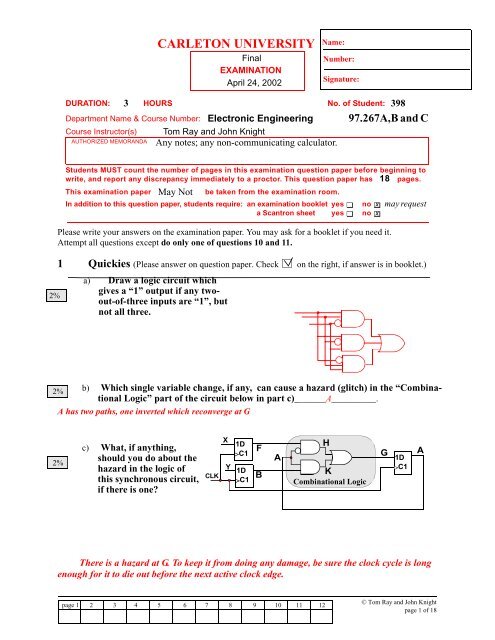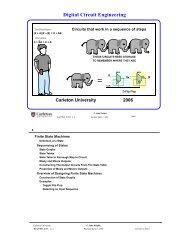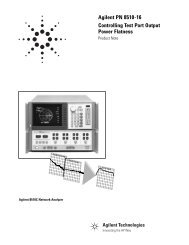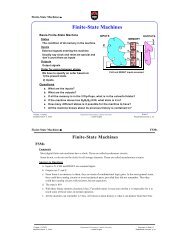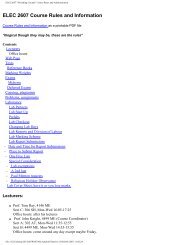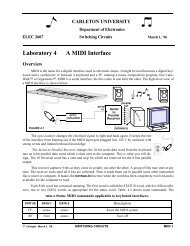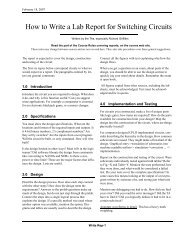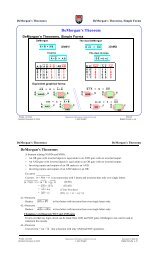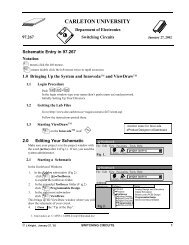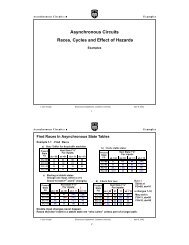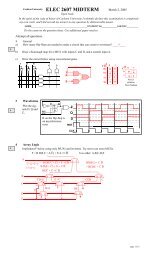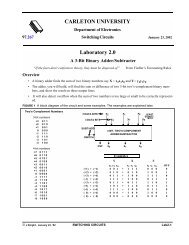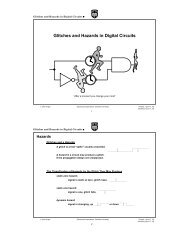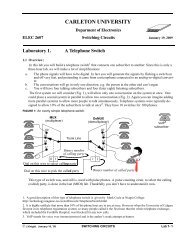CARLETON UNIVERSITY - Department of Electronics at Carleton ...
CARLETON UNIVERSITY - Department of Electronics at Carleton ...
CARLETON UNIVERSITY - Department of Electronics at Carleton ...
You also want an ePaper? Increase the reach of your titles
YUMPU automatically turns print PDFs into web optimized ePapers that Google loves.
<strong>CARLETON</strong> <strong>UNIVERSITY</strong><br />
DURATION: HOURS No. <strong>of</strong> Student:<br />
<strong>Department</strong> Name & Course Number:<br />
Course Instructor(s)<br />
AUTHORIZED MEMORANDA<br />
Final<br />
EXAMINATION<br />
April 24, 2002<br />
Students MUST count the number <strong>of</strong> pages in this examin<strong>at</strong>ion question paper before beginning to<br />
write, and report any discrepancy immedi<strong>at</strong>ely to a proctor. This question paper has 18 pages.<br />
This examin<strong>at</strong>ion paper May Not be taken from the examin<strong>at</strong>ion room.<br />
In addition to this question paper, students require: an examin<strong>at</strong>ion booklet yes no x may request<br />
a Scantron sheet yes no x<br />
page 1 2 3 4 5 6 7 8 9 10 11 12<br />
Name:<br />
Number:<br />
Sign<strong>at</strong>ure:<br />
3 398<br />
Electronic Engineering 97.267A,B and C<br />
Tom Ray and John Knight<br />
Any notes; any non-communic<strong>at</strong>ing calcul<strong>at</strong>or.<br />
Please write your answers on the examin<strong>at</strong>ion paper. You may ask for a booklet if you need it.<br />
Attempt all questions except do only one <strong>of</strong> questions 10 and 11.<br />
1 Quickies (Please answer on question paper. Check on the right, if answer is in booklet.)<br />
a) Draw a logic circuit which<br />
2%<br />
gives a “1” output if any twoout-<strong>of</strong>-three<br />
inputs are “1”, but<br />
not all three.<br />
2% b) Which single variable change, if any, can cause a hazard (glitch) in the “Combin<strong>at</strong>ional<br />
Logic” part <strong>of</strong> the circuit below in part c)_______A__________.<br />
A has two p<strong>at</strong>hs, one inverted which reconverge <strong>at</strong> G<br />
2%<br />
c) Wh<strong>at</strong>, if anything,<br />
should you do about the<br />
hazard in the logic <strong>of</strong><br />
this synchronous circuit,<br />
if there is one?<br />
CLK<br />
X<br />
Y<br />
1D<br />
C1<br />
1D<br />
C1<br />
F<br />
A<br />
H<br />
G<br />
1D<br />
A<br />
B<br />
K<br />
Combin<strong>at</strong>ional Logic<br />
C1<br />
There is a hazard <strong>at</strong> G. To keep it from doing any damage, be sure the clock cycle is long<br />
enough for it to die out before the next active clock edge.<br />
© Tom Ray and John Knight<br />
page 1 <strong>of</strong> 18
2%<br />
<strong>Carleton</strong> University <strong>Electronics</strong>, 97.267A, B and C Final April 24, 2002<br />
4%<br />
2%<br />
d) Many logic circuits run from a 5 volt power supply<br />
and receive and send out logic signals which have a<br />
logic “0” as 0 volts and a logic “1” as 5 volts. However<br />
in this instance the input signals are not the usual.<br />
C is 4.0 volts and B is 0.8 volts.<br />
Wh<strong>at</strong> logic level would you expect <strong>at</strong> A__0__<br />
Wh<strong>at</strong> logic level would you expect <strong>at</strong> R__1__<br />
4 V is an adequ<strong>at</strong>e 1, 0.8 V is an adequ<strong>at</strong>e 0.<br />
e) Simplify A+AB+BC+CD+DE+EF and don’t take too much space.<br />
=A+B +BC+CD+DE+EF (x+xz=x+z)<br />
=A+B +C+CD+DE+EF (x+xz=x+z)<br />
=A+B +C+D+DE+EF (x+xz=x+z)<br />
=A+B +C+D+E+EF (x+xz=x+z)<br />
=A+B +C+D+E (x+xz=x)<br />
f) Plot A·BC+BCDE on a Karnaugh map<br />
A·BC is on both maps.<br />
BCDE is on the E level (map only)<br />
+5 volt power supply<br />
© Tom Ray and John Knight April 14, 2003 page 2, <strong>of</strong> 18<br />
+<br />
C=4 volt<br />
B=0.8 volt<br />
AB\ CD AB\ CD<br />
1 1 1 1<br />
AB\ CD<br />
R<br />
E E<br />
AB\<br />
1 1<br />
CD<br />
1 1<br />
1<br />
A<br />
1a)See<br />
booklet<br />
1b)See<br />
booklet<br />
1c)See<br />
booklet
<strong>Carleton</strong> University <strong>Electronics</strong>, 97.267A, B and C Final April 24, 2002<br />
2 More Quickies<br />
a) Change to a minimal sum <strong>of</strong> products form.<br />
4%<br />
2%<br />
(A +BC)(A+EF)(ABC + DB )<br />
(AEF + ABC)(ABC + DB) swap<br />
AEFDB + ABC D2<br />
Taking the dual here is a mark loser.<br />
So is brute force multiplying out to 8 terms.<br />
People who did so almost alwas made a mistake, and none got the minimal answer.<br />
b) A minimized synchronous finite-st<strong>at</strong>e machine has<br />
11 inputs,<br />
14 outputs,<br />
40 st<strong>at</strong>es in which 3 are equivalent,<br />
and 129 logic g<strong>at</strong>es.<br />
How many flip-flops does it have?<br />
_________6_______<br />
6 flip-flops can give 2 6 st<strong>at</strong>es.<br />
5 flip-flops can only give 32.<br />
Pay no <strong>at</strong>tantion to all th<strong>at</strong> other confusing info.<br />
© Tom Ray and John Knight April 14, 2003 page 3, <strong>of</strong> 18<br />
2a)See<br />
booklet<br />
2b)See<br />
booklet
<strong>Carleton</strong> University <strong>Electronics</strong>, 97.267A, B and C Final April 24, 2002<br />
3%<br />
c) You have studied synchronous machines, asynchronous machines,<br />
Mealy outputs and Moore outputs.<br />
Which kind(s) <strong>of</strong> machine need race-free st<strong>at</strong>e assignments?<br />
_________________________asynch____________________________<br />
2%<br />
Which kind(s) <strong>of</strong> machine respond the most quickly to input changes?<br />
_______________________asynch______________________________<br />
_______________________Mealy_____________________________<br />
d) If 1101 is a two’s complement binary number, wh<strong>at</strong> is its value in decimal?<br />
1101 = -2 3 *1 + ( 2 2 *1 + 2 1 *0 + 2 0 *1 )= -8+5=-3,<br />
or 1101 0010<br />
+1<br />
0011 = 3dec<br />
hence the original was -3.<br />
© Tom Ray and John Knight April 14, 2003 page 4, <strong>of</strong> 18
<strong>Carleton</strong> University <strong>Electronics</strong>, 97.267A, B and C Final April 24, 2002<br />
3 MUX Logic and Hazards<br />
e) Implement the function F using one or more <strong>of</strong> the MUXs shown. You may<br />
use as many MUXs <strong>of</strong> any type as you need but:<br />
- do not change the inputs, or the ordering <strong>of</strong> the inputs, on the symbols.<br />
- do not use more hardware than needed for your method <strong>of</strong> implement<strong>at</strong>ion.<br />
4%<br />
abc<br />
000<br />
001<br />
010<br />
011<br />
100<br />
101<br />
110<br />
111<br />
abc<br />
ab<br />
00<br />
01<br />
10<br />
11<br />
a b<br />
bc<br />
00<br />
01<br />
10<br />
11<br />
bc<br />
f) Revise the equ<strong>at</strong>ion for H, below, to make the function free <strong>of</strong> st<strong>at</strong>ic hazards.<br />
Give the minimal form th<strong>at</strong> is still hazard free.<br />
7%<br />
F= ab + ac +ac<br />
Not well covered in 2003<br />
© Tom Ray and John Knight April 14, 2003 page 5, <strong>of</strong> 18<br />
ac<br />
00<br />
01<br />
10<br />
11<br />
a c<br />
c<br />
a<br />
b<br />
F= ab + ac +ac<br />
1<br />
0<br />
1<br />
1<br />
1<br />
0<br />
1<br />
0<br />
b+c c<br />
0<br />
c<br />
3a)See<br />
booklet
<strong>Carleton</strong> University <strong>Electronics</strong>, 97.267A, B and C Final April 24, 2002<br />
Put the circles (loops) for the hazard free function including masks on the right hand<br />
map.<br />
Write the equ<strong>at</strong>ion including masks below the map<br />
Blanks<br />
are zeros<br />
CD<br />
AB 00<br />
00 1<br />
D<br />
01 11 10<br />
1 1 1<br />
01 1 1<br />
A<br />
11 1<br />
10 1 1 1<br />
C<br />
CD<br />
AB 00<br />
00 1<br />
D<br />
01 11 10<br />
1 1 1<br />
01 1 1<br />
A<br />
11 1<br />
10 1 1 1<br />
C<br />
CD<br />
AB 00<br />
00 1<br />
D<br />
01 11 10<br />
1 1 1<br />
01 1 1<br />
A<br />
11 1<br />
10 1 1 1<br />
C<br />
H= AD +A B +BD + AC D + BC<br />
B<br />
B<br />
B<br />
H=A·B·D +AD+A·C·D +A·B·C<br />
CD<br />
AB 00<br />
00 1<br />
D<br />
01 11 10<br />
1 1 1<br />
01 1 1<br />
A<br />
11 1<br />
10 1 1 1<br />
C<br />
CD<br />
AB 00<br />
00 1<br />
D<br />
01 11 10<br />
1 1 1<br />
01 1 1<br />
A<br />
11 1<br />
10 1 1 1<br />
C<br />
CD<br />
AB 00<br />
00 1<br />
D<br />
01 11 10<br />
1 1 1<br />
01 1 1<br />
A<br />
11 1<br />
10 1 1 1<br />
C<br />
© Tom Ray and John Knight April 14, 2003 page 6, <strong>of</strong> 18<br />
B<br />
B<br />
B
8%<br />
<strong>Carleton</strong> University <strong>Electronics</strong>, 97.267A, B and C Final April 24, 2002<br />
4 Races and Cycles<br />
Do rough work on the top table.<br />
The bottom table will be marked.<br />
Arrows in the bottom table, which<br />
are not part <strong>of</strong> the answer, will give<br />
neg<strong>at</strong>ive marks.<br />
a) Indic<strong>at</strong>e any cycles or races.<br />
b) Indic<strong>at</strong>e the p<strong>at</strong>h(s) from an<br />
initial stable st<strong>at</strong>e by which<br />
one enters the cycle or race.<br />
c) Iftheracealonecouldcause<br />
the circuit to malfunction write<br />
BAD beside the arrow.<br />
If the circuit should function<br />
s<strong>at</strong>isfactorily with the race,<br />
writeOKbesidethearrow.<br />
For a cycle write CY inside the<br />
loop<br />
we hope you have formed from<br />
the arrows.<br />
Present Next St<strong>at</strong>e, p + ,q +<br />
St<strong>at</strong>e for inputs x,y<br />
© Tom Ray and John Knight April 14, 2003 page 7, <strong>of</strong> 18<br />
PQ<br />
x,y<br />
00<br />
x,y<br />
01<br />
x,y<br />
11<br />
x,y<br />
10<br />
00 00 01 10 00<br />
01 01 00 01 01<br />
11 00 11 11 10<br />
10 10 11 01 11<br />
Present Next St<strong>at</strong>e, p + ,q +<br />
St<strong>at</strong>e for inputs x,y<br />
PQ<br />
x,y<br />
00<br />
x,y<br />
01<br />
x,y<br />
11<br />
x,y<br />
10<br />
00<br />
01<br />
00<br />
01<br />
01<br />
cy<br />
00<br />
10<br />
01<br />
00<br />
01<br />
11 00 11 11 10<br />
cy<br />
10 10 11 01 11<br />
Present Next St<strong>at</strong>e, p + ,q +<br />
St<strong>at</strong>e for inputs x,y<br />
PQ<br />
x,y<br />
00<br />
x,y<br />
01<br />
x,y<br />
11<br />
x,y<br />
10<br />
00 00 01 10 00<br />
01 01 00 01 01<br />
11 00 11 11 10<br />
10 10 11 01 11<br />
Present Next St<strong>at</strong>e, p + ,q +<br />
St<strong>at</strong>e for inputs x,y<br />
PQ<br />
BAD<br />
x,y<br />
00<br />
x,y<br />
01<br />
x,y<br />
11<br />
x,y<br />
10<br />
00<br />
01<br />
00<br />
01<br />
01<br />
cy<br />
00<br />
10<br />
01<br />
00<br />
01<br />
11 00 11 11 10<br />
cy<br />
10 10 11 01 11<br />
BAD<br />
BAD<br />
4) See<br />
booklet
<strong>Carleton</strong> University <strong>Electronics</strong>, 97.267A, B and C Final April 24, 2002<br />
10%<br />
5 Minimiz<strong>at</strong>ion <strong>of</strong> Multiple Outputs<br />
Minimizethelogicsize.<br />
a) Show your final circles on the lower map, rough work on the top maps.<br />
b) Shade the circles th<strong>at</strong> are common to two or more maps.<br />
c) Write the logic equ<strong>at</strong>ions under the maps.<br />
YZ<br />
WX 00<br />
00<br />
Z<br />
01 11 10<br />
1 1 1<br />
YZ<br />
WX 00<br />
00 1<br />
Z<br />
01 11 10<br />
1 1<br />
YZ<br />
WX 00<br />
00<br />
Z<br />
01 11 10<br />
1<br />
01<br />
11<br />
W<br />
10 d<br />
1 1<br />
1<br />
1<br />
1<br />
X<br />
01<br />
11<br />
W<br />
10 d 1<br />
X<br />
01<br />
11<br />
W<br />
10 1<br />
1<br />
1<br />
1<br />
1<br />
1<br />
1<br />
Y<br />
Y<br />
Y<br />
Map <strong>of</strong> F<br />
Map <strong>of</strong> G<br />
Map <strong>of</strong> H<br />
3circlesto<br />
get 1 bit<br />
YZ<br />
WX 00<br />
00<br />
Z<br />
01 11 10<br />
1 1 1<br />
YZ<br />
WX 00<br />
00 1<br />
Z<br />
01 11 10<br />
1 1<br />
YZ<br />
WX 00<br />
00<br />
Z<br />
01 11 10<br />
1<br />
2circlesto<br />
get 1 bit<br />
01<br />
11<br />
W<br />
10 d<br />
1 1<br />
1<br />
1<br />
1<br />
X<br />
01<br />
11<br />
W<br />
10 d 1<br />
X<br />
01<br />
11<br />
W<br />
10 1<br />
1<br />
1<br />
1<br />
1<br />
1<br />
1<br />
X<br />
Y<br />
Y<br />
Y<br />
Can share<br />
but extra<br />
YZ<br />
WX 00<br />
00<br />
Z<br />
01 11 10<br />
1 1 1<br />
YZ<br />
WX 00<br />
00 1<br />
Z<br />
01 11 10<br />
1 1<br />
YZ<br />
WX 00<br />
00<br />
Z<br />
01 11 10<br />
1<br />
work to get<br />
1 and 1<br />
01<br />
11<br />
W<br />
10 d<br />
1 1<br />
1<br />
1<br />
1<br />
X<br />
01<br />
11<br />
W<br />
10 d 1<br />
X<br />
01<br />
11<br />
W<br />
10 1<br />
1<br />
1<br />
1<br />
1<br />
1<br />
1<br />
X<br />
Alot<strong>of</strong><br />
work for a<br />
d<br />
YZ<br />
WX 00<br />
00<br />
01<br />
11<br />
W<br />
10 d<br />
Y<br />
Z<br />
01 11 10<br />
1 1 1<br />
1 1 1<br />
1 1<br />
X<br />
YZ<br />
WX 00<br />
00 1<br />
01<br />
11<br />
W<br />
10 d<br />
Y<br />
Z<br />
01 11 10<br />
1 1<br />
1<br />
X<br />
YZ<br />
WX 00<br />
00<br />
01<br />
11<br />
W<br />
10 1<br />
Y<br />
Z<br />
01 11 10<br />
1<br />
1 1 1<br />
1 1 1<br />
X<br />
Y<br />
Y<br />
Y<br />
YZ<br />
WX 00<br />
00<br />
Z<br />
01 11 10<br />
1 1 1<br />
YZ<br />
WX 00<br />
00 1<br />
Z<br />
01 11 10<br />
1 1<br />
YZ<br />
WX 00<br />
00<br />
Z<br />
01 11 10<br />
1<br />
01<br />
11<br />
W<br />
10 d<br />
1 1<br />
1<br />
1<br />
1<br />
X<br />
01<br />
11<br />
W<br />
10 d 1<br />
X<br />
01<br />
11<br />
W<br />
10 1<br />
1<br />
1<br />
1<br />
1<br />
1<br />
1<br />
X<br />
A=WY<br />
Y<br />
Y<br />
Y<br />
B=WXZ<br />
F=A+B+C+XY G=Z X+C<br />
H=WX+A+B+C<br />
C=W X Y Z<br />
22 letters, 9 g<strong>at</strong>es<br />
© Tom Ray and John Knight April 14, 2003 page 8, <strong>of</strong> 18<br />
X
8% 12%<br />
<strong>Carleton</strong> University <strong>Electronics</strong>, 97.267A, B and C Final April 24, 2002<br />
6 St<strong>at</strong>e Graph <strong>of</strong> a Synchronous Machine<br />
Draw the st<strong>at</strong>e graph for a Moore machine which has one input X, and two out-<br />
puts Y and Z:<br />
Y=1 whenever the machine receives the sequence 1001.<br />
Z=1 whenever the machine receives the sequence 0101.<br />
The leftmost bit is received first.<br />
Overlapped sequences are to be detected.<br />
Y and Z are zero except for the single clock period after the appropri<strong>at</strong>e sequence<br />
is completed.<br />
The machine starts <strong>at</strong> the RESET st<strong>at</strong>e.<br />
Draw only the st<strong>at</strong>e graph<br />
Use only the st<strong>at</strong>es provided below and do not change anything already given.<br />
Got<br />
Nothing<br />
Got 0 Got 01 Got 010 Got 0101<br />
Got<br />
Nothing<br />
Reset<br />
YZ=00<br />
0 Tom<br />
YZ=00<br />
0<br />
1<br />
1<br />
Got 01011<br />
Got 1<br />
Got 10<br />
Got 100<br />
Got 1001<br />
Anita<br />
YZ=00<br />
1<br />
Got 11<br />
0<br />
YZ=00<br />
0<br />
Yana<br />
YZ=00<br />
1<br />
Got 011<br />
Y<strong>at</strong>ish<br />
0101<br />
Got 10011<br />
1001<br />
1<br />
1<br />
1<br />
0<br />
Dick<br />
YZ=00<br />
Prize<br />
YZ=10<br />
© Tom Ray and John Knight April 14, 2003 page 9, <strong>of</strong> 18<br />
0<br />
0<br />
Harry<br />
YZ=00<br />
Got 1000<br />
1<br />
Win<br />
YZ=01<br />
0<br />
Got 01010<br />
Got 0 <strong>of</strong> 0101<br />
Got Nothing <strong>of</strong> 1001<br />
Got 010<br />
Got 10010<br />
<strong>of</strong> 0101<br />
Got 10 <strong>of</strong> 1001<br />
1
<strong>Carleton</strong> University <strong>Electronics</strong>, 97.267A, B and C Final April 24, 2002<br />
.<br />
Got<br />
Nothing<br />
Got 1<br />
Got 10<br />
Got 100<br />
Got 1001<br />
Got<br />
Nothing<br />
Reset<br />
YZ=00<br />
1<br />
Anita<br />
YZ=00<br />
0<br />
1<br />
0<br />
1<br />
Got 0 Got 01 Got 010 Got 0101<br />
Tom<br />
YZ=00<br />
Y<strong>at</strong>ish<br />
YZ=00<br />
0<br />
Yana<br />
YZ=00<br />
0<br />
1<br />
1<br />
0<br />
1<br />
1<br />
Dick<br />
YZ=00<br />
Prize<br />
YZ=10<br />
© Tom Ray and John Knight April 14, 2003 page 10, <strong>of</strong> 18<br />
0<br />
0<br />
0<br />
Harry<br />
YZ=00<br />
1<br />
YZ=01<br />
0<br />
Win<br />
1
8% 7%<br />
<strong>Carleton</strong> University <strong>Electronics</strong>, 97.267A, B and C Final April 24, 2002<br />
7 St<strong>at</strong>e Graph to Timing Diagram<br />
CLK<br />
I<br />
St<strong>at</strong>e<br />
z<br />
For the st<strong>at</strong>e graph shown below:<br />
a) Find one impossibility, circle it. and say wh<strong>at</strong> it is (in 10 words or less).<br />
Answer__Two next st<strong>at</strong>es for the same input (I=1 in st<strong>at</strong>e B) is impossible.<br />
b) Complete the timing diagram from the st<strong>at</strong>e graph. Show the present st<strong>at</strong>e and the output Z.<br />
The impossibility in a) should not affect the answer.<br />
C<br />
I=0->z=1<br />
I=1->z=0<br />
I=0<br />
I=1<br />
R<br />
z=0<br />
I=0<br />
I=0<br />
I=1<br />
I=1<br />
B<br />
I=0->z=0<br />
I=1->z=1<br />
© Tom Ray and John Knight April 14, 2003 page 11, <strong>of</strong> 18<br />
I=1<br />
I=0<br />
D<br />
z=1<br />
I=1<br />
R D C B A<br />
I=0<br />
A<br />
z=1<br />
St<strong>at</strong>es only change on the clock edge.<br />
Check input just before the clock edge to calcul<strong>at</strong>e next st<strong>at</strong>e<br />
Look inside st<strong>at</strong>e bubble for outputs inform<strong>at</strong>ion.<br />
Only one input, so can just write 1, 0.<br />
C 0<br />
B<br />
z=I<br />
z=I<br />
Another way <strong>of</strong> giving outputs<br />
1<br />
I=1<br />
7)See<br />
booklet
8%<br />
<strong>Carleton</strong> University <strong>Electronics</strong>, 97.267A, B and C Final April 24, 2002<br />
8 St<strong>at</strong>e Table to Circuit<br />
Design a machine with minimum logic to implement the following st<strong>at</strong>e table.<br />
Only the K-maps and the combin<strong>at</strong>ional circuits for the D inputs (DA and DB ) and Z are expected.<br />
Do not change the st<strong>at</strong>es, st<strong>at</strong>e assignment or the oper<strong>at</strong>ion <strong>of</strong> the machine<br />
St<strong>at</strong>e<br />
Q A Q B<br />
.<br />
St<strong>at</strong>e Q A + QB +<br />
I=0 I=1<br />
Output Z<br />
I=0 I=1<br />
R=0 0 V T 0 1<br />
S=0 1 V T 0 0<br />
T=1 1 R S 1 0<br />
V=1 0 R S 0 0<br />
St<strong>at</strong>e<br />
Q A Q B<br />
St<strong>at</strong>e Q A + QB +<br />
I=0 I=1<br />
Output Z<br />
I=0 I=1<br />
R=0 0 V=1 0 T =1 1 0 1<br />
S=0 1 V=1 0 T=1 1 0 0<br />
T=1 1 R=0 0 S=0 1 1 0<br />
V=1 0 R=0 0 S=0 1 0 0<br />
Q I<br />
A QB 00<br />
01<br />
11<br />
10<br />
0 1<br />
1<br />
1<br />
0<br />
0<br />
D A= Q A<br />
1<br />
1<br />
0<br />
0<br />
D A =Q A +<br />
Q I<br />
A QB 00<br />
01<br />
11<br />
10<br />
0 1<br />
DA Circuit DB Circuit<br />
DA QA I DB QB 0<br />
0<br />
0<br />
0<br />
1<br />
1<br />
1<br />
1<br />
D B=Q B +<br />
D B =I<br />
QB QA Q I<br />
A QB 00<br />
01<br />
11<br />
10<br />
Z Circuit<br />
0 1<br />
© Tom Ray and John Knight April 14, 2003 page 12, <strong>of</strong> 18<br />
I<br />
0<br />
0<br />
1<br />
0<br />
1<br />
0<br />
0<br />
0<br />
Z=Q A Q BI+ Q A Q BI<br />
Z<br />
8)See<br />
booklet
<strong>Carleton</strong> University <strong>Electronics</strong>, 97.267A, B and C Final April 24, 2002<br />
9 St<strong>at</strong>e Reduction<br />
In the st<strong>at</strong>e table below, and using a merge table, find which st<strong>at</strong>es, if any are equivalent.<br />
Make a new st<strong>at</strong>e table with the minimum number <strong>of</strong> st<strong>at</strong>es<br />
. Changed one next st<strong>at</strong>e <strong>of</strong> B and C from original exam to make the problem a little harder.<br />
St<strong>at</strong>e Next St<strong>at</strong>e<br />
I=0 I=1<br />
Output<br />
Z<br />
R E A 1<br />
A E B 0<br />
B A B 0<br />
C E C 0<br />
D C R 0<br />
E D R 0<br />
A<br />
B<br />
C<br />
D<br />
E<br />
A<br />
B<br />
C<br />
D<br />
E<br />
Z=0<br />
Z=1<br />
Z=0<br />
Z=1<br />
Z=0<br />
Z=1<br />
Z=0<br />
Z=1<br />
Z=0<br />
Z=1<br />
Different outputs<br />
A B<br />
E B<br />
E C<br />
E B<br />
C R<br />
E B<br />
D R<br />
E B<br />
E C<br />
A B<br />
C R<br />
A B<br />
D R<br />
A B<br />
C R<br />
E R<br />
D R<br />
E R<br />
D R<br />
C R<br />
R A B C D<br />
Z=0<br />
Z=1<br />
Z=0<br />
Z=1<br />
Z=0<br />
Z=1<br />
Z=0<br />
Z=1<br />
Z=0<br />
Z=1<br />
A B<br />
E C<br />
E C<br />
E B<br />
C R<br />
E B<br />
D R<br />
E B<br />
E C<br />
A B<br />
C R<br />
A B<br />
D R<br />
A B<br />
C R<br />
E R<br />
D R<br />
E R<br />
D R<br />
C R<br />
R A B C D<br />
To merge st<strong>at</strong>es<br />
Must have the same output.<br />
Must have the same next st<strong>at</strong>es<br />
However<br />
They only have to be the same<br />
after all the mergers.<br />
Setting up the merge table<br />
BandAcan merge<br />
only if (A and E)<br />
and (B andC))<br />
are merged.<br />
AandEcan merge<br />
only if (B and R)<br />
and (D and E)<br />
are merged<br />
BandRhave<br />
different outputs!<br />
Thus DandE<br />
are irrelevant<br />
© Tom Ray and John Knight April 14, 2003 page 13, <strong>of</strong> 18
<strong>Carleton</strong> University <strong>Electronics</strong>, 97.267A, B and C Final April 24, 2002<br />
A<br />
B<br />
C<br />
D<br />
E<br />
A<br />
B<br />
C<br />
D<br />
E<br />
A<br />
B<br />
C<br />
D<br />
E<br />
Z=0<br />
Z=1<br />
Z=0<br />
Z=1<br />
Z=0<br />
Z=1<br />
Z=0<br />
Z=1<br />
Z=0<br />
Z=1<br />
A B<br />
E C<br />
E C<br />
E B<br />
C R<br />
E B<br />
D R<br />
E B<br />
E C<br />
A B<br />
C R<br />
A B<br />
D R<br />
A B<br />
C R<br />
E R<br />
D R<br />
E R<br />
D R<br />
C R<br />
R A B C D<br />
Z=0<br />
Z=1<br />
Z=0<br />
Z=1<br />
Z=0<br />
Z=1<br />
Z=0<br />
Z=1<br />
Z=0<br />
Z=1<br />
A B<br />
E C<br />
E C<br />
E B<br />
C R<br />
E B<br />
D R<br />
E B<br />
E C<br />
A B<br />
C R<br />
A B<br />
D R<br />
A B<br />
C R<br />
E R<br />
D R<br />
E R<br />
D R<br />
C R<br />
R A B C D<br />
Z=0<br />
Z=1<br />
Z=0<br />
Z=1<br />
Z=0<br />
Z=1<br />
Z=0<br />
Z=1<br />
Z=0<br />
Z=1<br />
A B<br />
E C<br />
E C<br />
E B<br />
C R<br />
E B<br />
D R<br />
E B<br />
E C<br />
A B<br />
C R<br />
A B<br />
D R<br />
A B<br />
C R<br />
E R<br />
D R<br />
E R<br />
D R<br />
C R<br />
R A B C D<br />
Gray squares<br />
have been<br />
elimin<strong>at</strong>ed as<br />
merger candid<strong>at</strong>es<br />
on previous<br />
iter<strong>at</strong>ion<br />
D C<br />
E C<br />
E D<br />
D C<br />
© Tom Ray and John Knight April 14, 2003 page 14, <strong>of</strong> 18<br />
E<br />
Three way<br />
merge
<strong>Carleton</strong> University <strong>Electronics</strong>, 97.267A, B and C Final April 24, 2002<br />
C will merge with D, C with E and E with D.<br />
Thus all three can merge into CDE..<br />
Review<br />
St<strong>at</strong>e Next St<strong>at</strong>e<br />
I=0 I=1<br />
OutputZ<br />
R CDE A 1<br />
A CDE B 0<br />
B R B 0<br />
CDE CDE R 0<br />
Assigning Bit-P<strong>at</strong>terns to Difficult St<strong>at</strong>e Graphs By Adding St<strong>at</strong>es<br />
A difficult st<strong>at</strong>e graph<br />
A B K<br />
D<br />
R<br />
Triangular st<strong>at</strong>es connections<br />
like ADR, can never all differ<br />
by only one bit<br />
Here A and R could not be<br />
made adjacent because<br />
<strong>of</strong> the triangle.<br />
00<br />
01<br />
11<br />
10<br />
0 1<br />
A B<br />
D R<br />
Assigning Bit-P<strong>at</strong>terns to St<strong>at</strong>es Using Flow-Through St<strong>at</strong>es.<br />
A difficult st<strong>at</strong>e graph<br />
x,y=1,1<br />
x,y=0,d<br />
A B K<br />
D<br />
xy=1,1<br />
R<br />
Triangular connections<br />
x,y=1,1<br />
K<br />
A B K<br />
© Tom Ray and John Knight April 14, 2003 page 15, <strong>of</strong> 18<br />
D<br />
α<br />
x,y=0,d<br />
A B K<br />
D<br />
x,y=1,1<br />
R<br />
R<br />
Add a temporary<br />
st<strong>at</strong>e α to elimin<strong>at</strong>e<br />
the triangle<br />
Since x,y=1,1 sends both R and<br />
D to A, let R flow through D.<br />
(D acts as a transient st<strong>at</strong>e)<br />
00<br />
01<br />
11<br />
10<br />
The new st<strong>at</strong>e<br />
assignment<br />
without races<br />
00<br />
01<br />
11<br />
10<br />
0 1<br />
A D<br />
α R<br />
B<br />
0 1<br />
A<br />
B K<br />
R<br />
D<br />
K<br />
Race free<br />
Assignment
12%<br />
<strong>Carleton</strong> University <strong>Electronics</strong>, 97.267A, B and C Final April 24, 2002<br />
10 Race-Free St<strong>at</strong>e Assignment. (Do either question 10 or 11 but not both.)<br />
For the following st<strong>at</strong>e table, revise the table and select a race-free assignment<br />
.Do not change the machine any more than necessary.<br />
Keep R as st<strong>at</strong>e 001.<br />
Do not increase the number <strong>of</strong> rows in the table. Do not merge st<strong>at</strong>es.<br />
Enter all <strong>of</strong> your answers below --- means “don’t care”<br />
.<br />
St<strong>at</strong>e Next<br />
St<strong>at</strong>e,<br />
Input<br />
XY=00<br />
Next<br />
St<strong>at</strong>e,<br />
Input<br />
XY=01<br />
Next<br />
St<strong>at</strong>e,<br />
Input<br />
XY=11<br />
Next<br />
St<strong>at</strong>e,<br />
Input<br />
XY=10<br />
A --- A A B<br />
B E --- --- B<br />
C C A C B<br />
D C D R D<br />
E E D C E<br />
R NotC<br />
Allowed<br />
A R D<br />
St<strong>at</strong>e Next<br />
St<strong>at</strong>e,<br />
Input<br />
XY=00<br />
Next<br />
St<strong>at</strong>e,<br />
Input<br />
XY=01<br />
Next<br />
St<strong>at</strong>e,<br />
Input<br />
XY=11<br />
Next<br />
St<strong>at</strong>e,<br />
Input<br />
XY=10<br />
A --- A A B<br />
B E --- --- B<br />
C C A C B<br />
D C D R D<br />
E E D C E<br />
R C A R D<br />
B<br />
C<br />
A R<br />
© Tom Ray and John Knight April 14, 2003 page 16, <strong>of</strong> 18<br />
C<br />
Assign st<strong>at</strong>es<br />
on map.<br />
Circle stable st<strong>at</strong>es<br />
Identify allowed<br />
st<strong>at</strong>e transitions<br />
Make graph<br />
<strong>of</strong> allowed<br />
transitions<br />
B<br />
C<br />
E<br />
A R<br />
C<br />
D<br />
Trytogetrid<strong>of</strong><br />
triangles.<br />
D<br />
B E<br />
Use transient st<strong>at</strong>es<br />
to avoid races.<br />
00<br />
01<br />
11<br />
10<br />
0 1<br />
A<br />
R<br />
C D<br />
B E
12%<br />
.025%<br />
<strong>Carleton</strong> University <strong>Electronics</strong>, 97.267A, B and C Final April 24, 2002<br />
Answer: Fill in the st<strong>at</strong>e table. Use letters to represent st<strong>at</strong>es, as above.<br />
Write your st<strong>at</strong>e assignmnt in a table (K-map).<br />
St<strong>at</strong>e Next St<strong>at</strong>e,<br />
Input<br />
XY=00<br />
Next St<strong>at</strong>e,<br />
Input<br />
XY=01<br />
Next St<strong>at</strong>e,<br />
Input<br />
XY=11<br />
Next St<strong>at</strong>e,<br />
Input<br />
XY=10<br />
A A=000 A=000 C=010<br />
B E=111 C=010 B=110<br />
C C=010 A=000 C=010 B=110<br />
D D=011 D=011 R=001 D=011<br />
E E=111 D=011 B=110 E=111<br />
R C=010 A=000 R=001 D=011<br />
11 Race-Free St<strong>at</strong>e Assignment. (Do either question 10 or 11 but not both.)<br />
A master-slave D flip-flop can be made differently than was shown in the notes.<br />
a) Find the best place(s) to break the circuit for analyze. Try to use the minimum<br />
number <strong>of</strong> breaks.<br />
z<br />
b) Label the next-st<strong>at</strong>e/st<strong>at</strong>e variables across breaks like this<br />
c) Derive the equ<strong>at</strong>ions rel<strong>at</strong>ing the variable on the left side <strong>of</strong> the break to the inputs and the<br />
variables on the right hand side <strong>of</strong> the break. Make appropri<strong>at</strong>e circuit simplific<strong>at</strong>ions graphically.<br />
+<br />
Z<br />
C<br />
D<br />
C<br />
D<br />
E<br />
N<br />
M<br />
F<br />
E<br />
N<br />
M<br />
F<br />
C<br />
m M +<br />
N<br />
C<br />
© Tom Ray and John Knight April 14, 2003 page 17, <strong>of</strong> 18<br />
C<br />
M<br />
N<br />
C<br />
V<br />
P<br />
W<br />
V<br />
P<br />
W<br />
q +<br />
00<br />
01<br />
11<br />
10<br />
0 1<br />
A R<br />
C D<br />
B E<br />
Q<br />
Q P<br />
Q<br />
Q P
.025%<br />
<strong>Carleton</strong> University <strong>Electronics</strong>, 97.267A, B and C Final April 24, 2002<br />
C<br />
D<br />
C<br />
D<br />
E<br />
N<br />
M<br />
F<br />
E=C+D<br />
N<br />
M<br />
F=DC<br />
m +<br />
C<br />
N=M+DC<br />
C<br />
M<br />
N<br />
C<br />
M<br />
When 2002 is written in binary, wh<strong>at</strong> will the least significant bit be?_______<br />
Have a good summer! Even numbers end in 0.<br />
© Tom Ray and John Knight April 14, 2003 page 18, <strong>of</strong> 18<br />
C<br />
V<br />
P<br />
W<br />
V=M+C<br />
Q<br />
W=CN<br />
Q<br />
Q P<br />
P<br />
q +<br />
Q<br />
P=Q+W=Q+CN<br />
m+=(M + F)(C + D) = (M + DC)(C + D) = MC+ MD + DC = MC + DC (concensus)<br />
q + = (Q+W)(C+M) = (Q+CN)(C+M) = QC+QM+CNM) = QC+QM+C(M+DC)M<br />
=QC+QM+CM=QC+CM (concensus)<br />
Note


